If you’re visiting Denmark in Europe with your dog, whether it’s just a quick trip to Copenhagen or you’re exploring the rest of the country by car, there’s plenty of dog-friendly things to do in Denmark.
Check out my top recommendations, particularly if you visit during the summer months of the year, plus the rest of my tips for travelling in Denmark with a dog.

Travelling to Denmark with a Dog
The standard EU rules apply to travelling to Denmark with your dog. If you are travelling to Denmark from another EU country or Norway, your dog will need to be microchipped, have an EU (or Norwegian) pet passport and have been vaccinated for rabies at least 21 days before crossing the border.
If you are flying to Denmark from outside of the EU, as well as a microchip and valid rabies vaccine, your pet will require an EU health certificate (also known as the Annex IV). In some cases a rabies titre test is also required. Check out the full details on travelling to Europe with a dog.
Dining Out in Denmark with a Dog
On our second day visiting Denmark, we were heading to lunch on the outskirts of Copenhagen when the heavens opened, and a furious downpour began. After sheltering in the carpark until the worst was over, we ventured out and were concerned about where we’d eat. We were wanting a nice sit-down lunch as it was my husband’s birthday, but surely no restaurant would allow us inside with our dog?
Standing outside a restaurant that would normally have an outdoor terrace, but that was now soaking wet and not possible to dine in, we tentatively asked the waiter at the door.
He welcomed us inside, stating that there’s no law against allowing dogs inside restaurants inside Denmark, and that we weren’t the only ones dining there with a dog. We’d just have to make do with a limited menu, as the storm had knocked out the electricity!

So, when you’re visiting Denmark, feel free to ask restaurants and cafes if they would allow your dog inside. Not all places will allow dogs, but it’s certainly worthwhile trying. Although when it’s sunny, there’s no better places to dine out than the many outdoor terraces, such as in the Nyhavn District in Copenhagen.
Or for a quick bite on the go, don’t overlook the hotdog stands in Denmark. The Danes have turned the humble hotdog into an artform, with varied toppings available. Its perfect for quick meal on a park bench, with your dog at your feet!
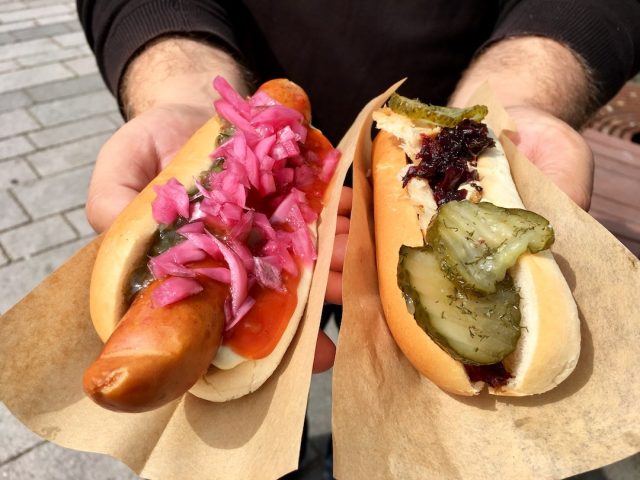
Taking a Dog on Public Transport in Denmark
Dogs are generally allowed to join you on public transport in Denmark, although there are different rules on different types of transport.
These are mainly for the benefit of allergy sufferers – to keep sections of public transport dog free. If in doubt, just look for the signage or ask a local to help translate – most Danes speak excellent English.
Dogs on Regional Trains in Denmark
While the easiest way to travel around Denmark is by car, especially to get to some destinations in the countryside, it’s also possible to travel around most of country with your dog by train, including some great day trips from Copenhagen.
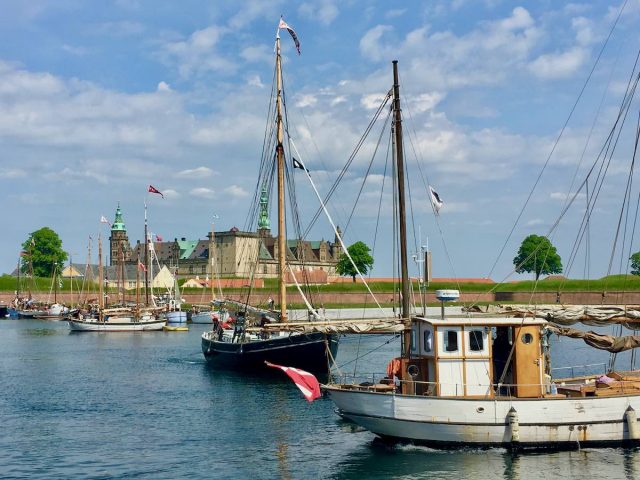
Both small and large dogs are allowed on trains in Denmark, including the trains that cross international borders, but only in selected sections of the train.
When boarding trains in Denmark with a dog, keep an eye out for the dog-free areas, marked with a crossed out dog. Dogs are also not permitted in the first class or the quiet zone.
Small dogs travelling in a carrier travel for free, without a ticket. The carrier should be no larger than 100 x 60 x 30 cm. Larger dogs require a child’s ticket, and must remain leashed and on the floor.
If booking a ticket with a seat reservation, make sure you only book a seat in the standard section, avoiding the dog-free sections.
Note also that some Swedish trains run into Denmark, particularly on the stretch between Copenhagen Airport and the city centre. These trains have a specific dog section (follow the arrows), that you should sit in.
Dogs on Public Transport in Copenhagen
In Copenhagen, dogs are most welcome on the S-trains and the metro services.
On S-train services, dogs are allowed in selected train carriages, roughly every second carriage. Look out for the dogs not allowed and dogs allowed symbols at the door. On the metro, dogs are not permitted at the front and end seats – look out for the symbols.
The rules are more complicated on buses. For starters, larger dogs are not allowed on A-buses (that have bus numbers ending in an “A”), except in Køge, Roskilde, Næstved, Ringsted, Holbæk and Helsingør. However, small dogs in a carrier are still allowed.
On other buses in the Greater Copenhagen area, larger dogs are not allowed in peak hour (7am to 9am and 3:30pm to 5:30pm on weekdays) in zones 1-4, 30-33 and 40-44. When allowed on buses, all dogs must travel in the back half of the bus.
Across the metro, buses and trains in Copenhagen, the rules for tickets are more consistent. Small dogs and other pets in a carrier (not exceeding 100 x 60 x 30cm) can ride for free, while larger dogs need to have a child’s ticket.
Dog-Friendly Accommodation in Denmark
There’s plenty of dog-friendly accommodation throughout Denmark. For example, when I reviewed the percentage of dog-friendly hotels in Copenhagen, I was surprised that 41% of hotels on Booking.com allowed dogs (although probably only in selected pet-friendly rooms).
However, hotels are generally quite expensive in Denmark, and I have a feeling that the more affordable hotels are not quite as dog-friendly. I recommend also investigating Airbnbs, both in Copenhagen and throughout the rest of Denmark.
Dog-Friendly Sightseeing in Denmark
There’s plenty of dog-friendly things to do in Denmark. Tick off some or all of these when visiting the country, both in Copenhagen and throughout the rest of the country…
1. Visit Colourful Nyhavn in Copenhagen
A visit to Denmark isn’t complete without a visit to the the picturesque district of Nyhavn in Copenhagen. Stretching along the sides of a canal, it’s packed full of colourful houses that make for the best photo spot.
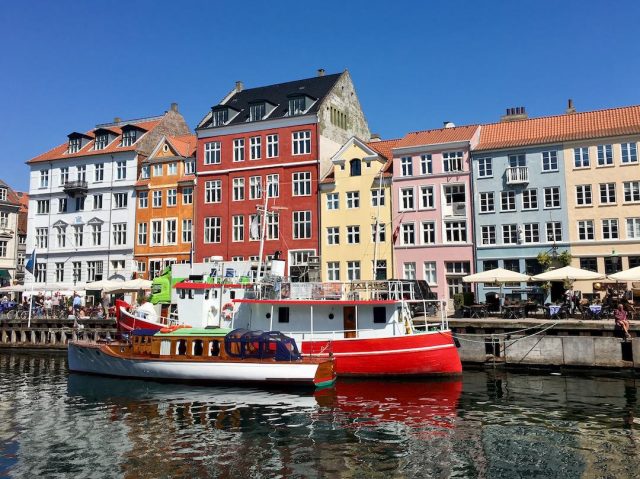
These days many of the buildings are home to restaurants, generally with expansive outdoor terraces on the northern side. Alternatively, grab a take-away beer to enjoy along the canal, or visit the annual Christmas market in winter time. Your dog will enjoy a stroll through this district just as much as you.
2. Take a Cruise on Copenhagen’s Harbour
While you’re at Nyhavn, you can jump onto a harbour cruise around Copenhagen at the top of the canal. A cruise will take you down to the main section of the harbour, past the Little Mermaid statue, past Our Saviours Church, and around Christiansborg Palace. It’s an easy way to see much of this harbour city, without tiring your feet, particularly when the weather is hot.

The main cruise operator is Stromma. Choose between a 1-hour guided cruise for DKK 109 per adult, or else buy a hop-on-hop-off pass valid for 48 hours for DKK 299 per adult.
Small, well-behaved dogs are allowed on their boats, as long as they can fit in a bag and are used to being around other people. They are also allowed on their hop-on hop-off buses, again in a bag, but only on the open-air top deck.
Alternatively, just down the canal on the right-hand-side you can hop on a boat with Netto Boats for a cheaper price – the cruise is still DKK 50 per adult (as of 2023). Our dog was welcome on their boat.
3. Head to Historic Jelling
The small village of Jelling in Jutland, on the Danish mainland, is famous for its historic monuments from the Viking era, including the Jelling Stone. There are actually two rune stones side by side at Jelling, the smaller erected by King Gorm and the larger more significant stone by Harald Bluetooth.
On the larger stone, Harold Bluetooth’s achievements are listed, including his unification of Denmark. The stone has been dubbed the “birth certificate of Denmark”. The stone also contains the oldest depiction of Christ in Scandinavia.
Both stones are free to visit, protected behind plastic boards. It’s possible to walk up to them with your dog, although naturally keep your dog on a leash and be careful at this historic site.

The site also contains two burial mounds constructed by Harald Bluetooth in memory of his parents, and underneath lies the remains of a Viking period ship. Both mounds can be walked upon. There is also an historic church and museum on site, although no pets are allowed inside.
4. Visit the Site of Hamlet
Shakespeare’s famous play Hamlet was set in Denmark, in the fictional castle of Elsinore. It’s widely believed to be based on Kronborg Castle, in the similarly named town of Helsingør, which is now UNESCO World Heritage listed.

While dogs are not allowed inside the castle, both dogs and humans are free to roam around the outside grounds around the castle. It’s set right on the sound separating Denmark and Sweden, with the Swedish town of Helsingborg visible across the water.
Helsingør is easily reached by a 45 minute train from Copenhagen Central Station. Kronborg Castle is then a scenic 10 minute walk from Helsingør train station.
5. Visit Roskilde Viking Ship Museum
Just outside of Copenhagen at Roskilde there’s two big attractions: Roskilde Cathedral, the burial site of most Danish kings and queens, and Roskilde Viking Ship Museum.
While the cathedral not surprisingly doesn’t allow dogs, dogs are welcome in the outdoor areas of the Viking Ship Museum, although they aren’t permitted in the Viking Ship Hall.
Roskilde is a quick 25 minute train from Copenhagen Central Station. At the time of my visit, it was cheaper to buy a day ticket than two single tickets for the train. It’s then a 20 minute walk to the Viking Ship Museum.
6. Drive to the Island of Mandø
When I say drive to an island, I really meaning driving to an island!
Mandø is one of the Wadden Sea islands located not far off the west coast of Denmark, near the historic town of Ribe. A 4km-long gravel causeway connects the island to the mainland.
While the causeway can become inaccessible at high tides during storms, it is fine to drive across in a regular vehicle during low or mid tide. I recommend driving across to the island at low tide, so you can best see the surrounding mudflats and spot the prolific birdlife.
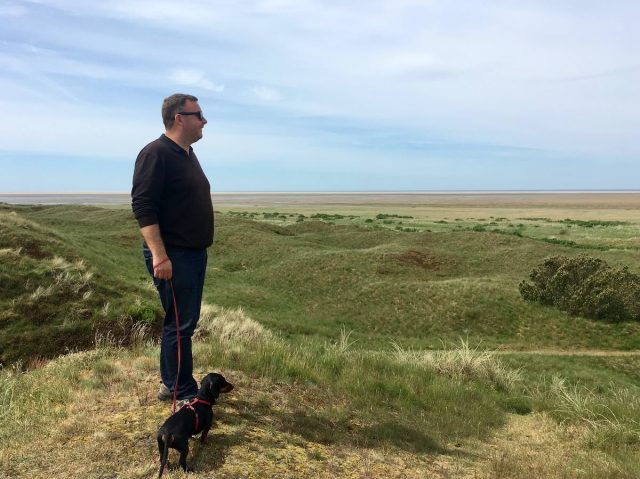
The actual island is quite small, with some quaint houses and windmills. It’s a relaxing spot, although there’s a couple of cafes located on the island, where you can sit at an outdoor table with your dog.
The island can also be visited on a tractor bus, that drives out onto the mudflats, although we just drove across and went for a walk with our pup.
8. Explore Historic Christiansfeld
The town of Christiansfeld was founded in what is now Southern Jutland in the late 18th century. It was founded by the Moravian Church and planned to represent the Protestant urban ideal.
At the town’s centre is the Church and its square, with the buildings throughout the town a homogenous and unadorned yellow brick with red tile roofs.
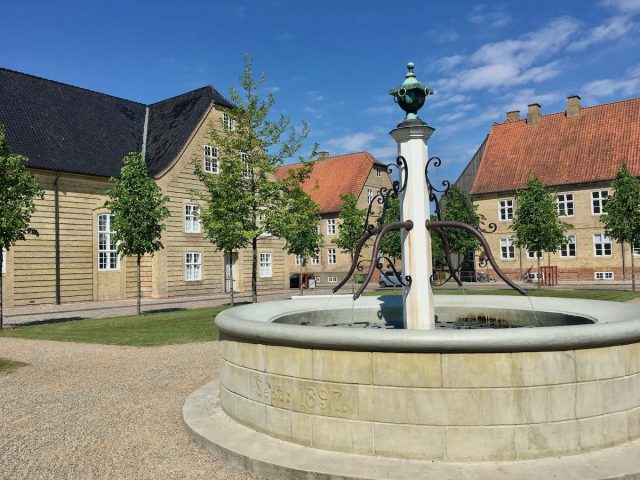
The town is exceptionally well preserved and has recently been listed on the UNESCO World Heritage list as an example of a religious settlement.
Stop off and pick up a map of the town, then head out for a stroll, with dogs on a leash permitted except for inside the opened buildings, such as the Church. Don’t also miss out on picking up some of the traditional honey cake from the local bakery.
9. Relax in the King’s Garden
For a relaxing time in Copenhagen head to one of its many wonderful parks. Dogs are allowed inside most parks, so take your pick.
Our favourite in the city was Kongens Have, or the King’s Garden. It’s also known as Rosenborg Castle Gardens, as it was originally the private gardens of the King’s Rosenborg Castle, right next door. It’s the oldest and most-visited park in central Copenhagen, and a great spot to enjoy a picnic.
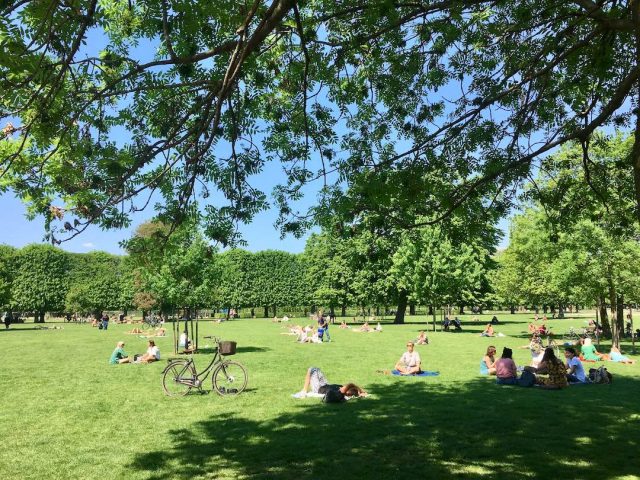
You May Also Like
About the Author

Shandos Cleaver is the founder of Travelnuity: Dog-Friendly Travel. She has travelled extensively with her Miniature Dachshund, Schnitzel, including to 33 countries across Europe, every state and territory of Australia except Tasmania, and 10 of the United States. She’s passionate about providing inspiration and information to others wanting to travel with their dogs, whether close to home or internationally.
Inspired? Pin this to your Pinterest board!
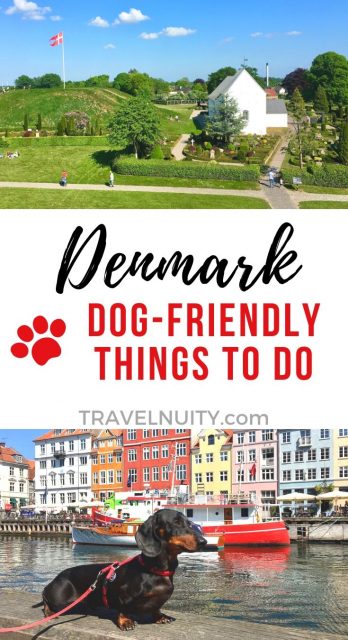

Hi Shandos,
Thanks for your great advice on traveling with dogs. In 2 weeks we are going to visit Denmark (and especially Copenhagen) with a motorhome and our aussie(!) called Bailey, so your articles site are a very useful resource for us 😉
Greetings from the Czech Republic,
Petr and Katerina
Thanks so much, have a great time!